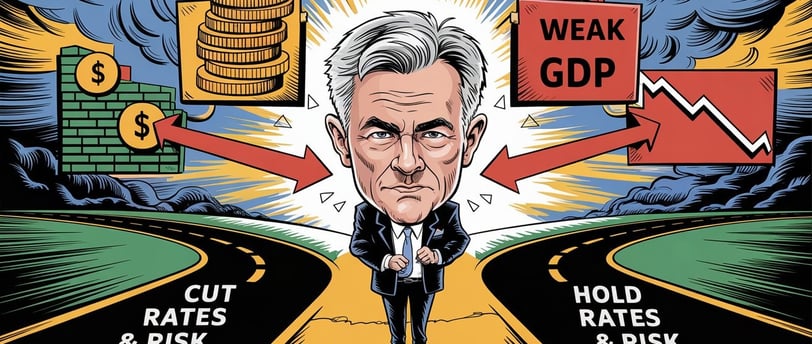Tariffs Paused, But the Real Game is Elsewhere: Why the End of Fed's QT is Key for the Next Crypto Rally
The path for the crypto market is becoming clearer, but the fog of uncertainty hasn't fully lifted. Tensions between the US and China and the famous tariffs remain on the radar, even with the recent postponement for 70 countries. But is this the main point we should be focusing on RIGHT NOW? Maybe not. The true protagonist in this phase of the game seems to be someone else: our "hero" Jerome Powell, the Fed Chair. The pressure on him is immense, and his next decisions, especially regarding the end of Quantitative Tightening (QT), could be the trigger the market is waiting for. Forget the daily news noise for a moment – what really matters now is LIQUIDITY. Let's understand why.
4/16/20255 min read


Tariffs Paused, But the Real Game is Elsewhere: Why the End of Fed's QT is Key for the Next Crypto Rally
The path for the crypto market is becoming clearer, but the fog of uncertainty hasn't fully lifted. Tensions between the US and China and the famous tariffs remain on the radar, even with the recent postponement for 70 countries. But is this the main point we should be focusing on RIGHT NOW? 🤔
Maybe not. The true protagonist in this phase of the game seems to be someone else: our "hero" Jerome Powell, the Fed Chair. The pressure on him is immense, and his next decisions, especially regarding the end of Quantitative Tightening (QT), could be the trigger the market is waiting for. Forget the daily news noise for a moment – what really matters now is LIQUIDITY. Let's understand why.
Tariff Noise vs. Liquidity Signal
Focusing solely on headlines can be dangerous (remember Trump's fund selling Ethereum at a loss?). The smart strategy is to look at the macro context and fundamentals.
Tariffs on Standby: Temporary Relief or Smokescreen?
Postponing tariffs for 90 days for many countries brought momentary relief, but uncertainty about what happens next persists. This tension, however, might be part of a bigger game.
China Selling Bonds: Calculated Pressure?
We recently saw China selling US Treasury bonds, which pushed up long-term US interest rates (bond yields). This seems like a response to tariff threats, a way to pressure the US economy and, indirectly, the Fed, as Trump openly wants lower interest rates. However, China can't do this for long without hurting itself. It's a battle of giants with an expiration date.
Why the Focus Should Be on the Fed (Not Just the News)
The crucial point is that all this movement (tariffs, bond selling) seems to converge towards one goal: putting the Fed against the wall, forcing it to act. And the most anticipated action isn't just cutting rates, but stopping the withdrawal of liquidity from the market.
Jerome Powell Against the Wall: The Monetary Policy Dilemma
The Fed is at a crossroads ("tricky situation"). The official narrative still expresses caution about inflation to justify keeping rates high. But the data and pressures tell a different story.
Inflation Fears vs. Current Data (PCE, Breakeven Falling)
While the Fed mentions the inflationary risk of tariffs (which are more COST-push inflation, not monetary), recent data shows the opposite:
Inflation (CPI, PCE): Came in BELOW expectations (e.g., 2.4% vs 2.5%).
Inflation Expectations (Breakeven): Have plummeted, returning to levels seen in April/May 2024, which preceded rate cut talks. The pause on tariffs and a weaker economy might keep inflation tame, giving the Fed room to act.
The Urgent Need for Lower Rates (Debt, Stimulus)
Besides controlled inflation, other factors are pushing for lower rates:
US Debt Refinancing: Trillions in debt mature this year and need to be rolled over. At current rates (~4.5%), the cost would be extremely high compared to the existing average debt rate (~3.3%). Lower rates are almost a fiscal necessity.
Economic Stimulus: Lower rates encourage credit, investment, employment, and corporate profits, something Wall Street loves and the economy needs after the slowdown ("suffer now, glory later").
Market Expectations: Cuts Ahead (June?), But Is It Enough?
The market is already pricing in multiple rate cuts later this year (up to 4 cuts!). Tools like the FedWatch Tool indicate over an 80% chance of a cut as early as June 2025. The question is: are rate cuts alone enough?
The Overlooked Key Point: The Crucial Importance of Ending QT
Here's the kicker many ignore: more important than the interest rate itself is the volume of money in the system. And that's where Quantitative Tightening (QT) comes in.
What is Quantitative Tightening (QT) and Why Does It Matter?
Since 2022, the Fed has been conducting QT: withdrawing liquidity from the market by reducing its balance sheet (selling or not reinvesting the bonds it holds). Less money circulating acts as a brake on risk assets.
The Historical Correlation: Fed Balance Sheet, BTC Dominance, and Altcoins
History is clear (and charts prove it):
When the Fed's balance sheet is stable or growing (liquidity injection): Bitcoin dominance tends to FALL, making room for Altcoin Season (like in 2016-17 and 2020-21). Bitcoin's price also tends to rise.
When the Fed's balance sheet is shrinking (QT): Bitcoin dominance tends to RISE, and altcoins suffer. This is what we've seen since 2022.
When Should QT End? Signs Point to Mid-2025 (May/June)
The good news: the Fed itself signaled in minutes (from January!) that the end of QT would likely occur around mid-2025 (May/June). They have already slowed the pace (from $25bn to $5bn/month in government bonds, though $35bn/month in MBS continue to roll off). The expectation is that in May or June, they might completely stop this $5bn withdrawal and perhaps even start repurchasing bonds. This is the signal that could unlock the market.
Global Liquidity and the Dollar: Missing Puzzle Pieces
The global picture also matters.
Global Liquidity Index (GLI) Rises, But With a Catch
The GLI (Global Liquidity Index) is rising, which is positive. This reflects money printing by China, Japan, and Europe. We saw a similar divergence (GLI rising, crypto falling) in 2024, which preceded a rally. BUT BEWARE: It's crucial to differentiate:
Monetary Inflation (M2, etc.): Is rising (China, etc.).
Central Bank Balance Sheets (especially Fed): Is still falling/sideways. It's the second part that needs to turn (or at least stop falling) to strongly boost altcoins.
The Dollar (DXY) at Critical Support: The Necessary Drop
A weaker dollar generally means more global liquidity and is good for risk assets like crypto. The DXY index is testing important support that has held multiple times since 2023. We need it to break this support to confirm the weakening trend and add more fuel to the crypto market.
Updated Crypto Strategy: Preparing for the Turning Point
Given this scenario, how should you position yourself?
Volatility and Sideways Action Expected (Range $70k-$93k?)
Until the Fed gives a clear signal about ending QT (likely in May/June), expect volatility and potential sideways movement. The range between $73k and $93k remains a probable zone, with the possibility of a test of the $70k liquidity area still on the radar.
The Market's "Gift": Time for DCA, Cash, and Passive Income
This waiting period isn't wasted time. It's a "gift" to:
Accumulate via DCA: Continue buying Bitcoin and solid altcoins at potentially better prices.
Hold/Build Cash: Have ammunition ready for when clarity arrives.
Generate Passive Income: Explore yield strategies to earn returns on capital while waiting.
The Final Trigger: End of QT as the Signal for the Cycle's "Last Gasp"
The end of QT by the Fed is the most likely trigger for the next major up-phase, possibly the strong "last gasp" of this market cycle, where altcoins might finally have their moment to shine more intensely.
Conclusion: Focus on Liquidity, Not the Drama
Forget the tariff saga for now. The main story to follow in the next 1-2 months is the Federal Reserve and the end of Quantitative Tightening. Inflation seems under control, economic and political pressure is high, and the Fed itself has signaled the timing.
Patience, strategy, accumulation, and a focus on liquidity are the watchwords. The market is providing time for repositioning before the potential next big wave.
Want to know exactly when the Fed flips the switch and how to adjust your portfolio? Keep following us! We provide in-depth analyses on these crucial signals to help you ride the entire cycle intelligently.
